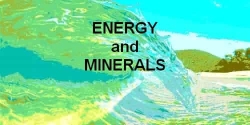Minerals Exploration Checklist
Minerals Exploration Checklist
Adapted from a talk by Dr. Gerry Carlson, President La Teko Resources Ltd.1. Logistics:
- Access
- Available topographic maps
- Available air photos
- Physical conditions - topography, outcrop pattern
- Climate
- Ore Minerals
- Alteration Host rocks
- - both for model deposit and for actual deposit characteristics
- - information sources geological maps, geologists, local knowledge, local mines and prospects
Available geological maps and reports combined with information concerning geological associations of known target/deposit types help tomorrow down the area of search and highlight the prime prospecting terrain.
PROSPECTING METHODS
A. Ore Exposed at Surface
Although some may feel that all significant ore deposits exposed at surface have already been discovered, they are wrong. New logging roads are being cut, glaciers are receding and trees are falling over, all exposing new outcrop. In addition, many ore deposits, especially gold, are difficult to recognise at surface. One of the most important prospecting methods therefore is simply breaking open as much outcrop and locally derived boulders as you can. Examine fresh faces on each broken piece with your handlens for evidence of mineralisation or associated alteration. When in doubt, label and save the specimen for geochemical analysis or assay or examination by a professional.
B. Ore Covered by Thin Overburden Layer
1.Geology:
2.Recognize alteration in outcrop (see above).
3.Recognize ore minerals or alteration in locally derived boulders collected from overburden or stream channel.
Geochemistry:
4.Sample altered bedrock for geochemical analysis, possibly recognise slightly enhanced metal values.
5.Sample soil for geochemical analysis, outlining an area of enhanced metal values.
6.Sample stream sediment for geochemical analysis, outlining a portion of the drainage basin with enhanced metal values.
Geophysics:
(Broadly speaking, the five properties that geophysics seeks to measure are: magnetic fields; electrical fields; gravity fields; radiation; and rock density).
7.If the ore or associated rocks contain magnetic minerals, such as magnetite or pyrrhotite, look at government airborne magnetic maps or carry out a ground magnetic survey.
8.If the ore is massive and conductive, consider an electromagnetic survey such as VLF or HLEM (horizontal loop).
9.If the ore is disseminated, consider an IP survey.
10.If the rocks associated with the deposit have differing geophysical characteristics or if they are faulted, all of the above geophysical techniques can provide information about the bedrock geology.
11.If the ore is massive and much denser than the surrounding rock, and if the topography is subdued, a gravity survey could be considered.
C. Ore Covered by Thick Overburden or Bedrock
In this case, all of the above prospecting methods apply except for direct observation, method 1. Geology is still a useful tool to outline the appropriate regional environment for the occurrence of the target deposit type, but direct ore associations and alteration are usually hidden. In addition, because of the thicker overburden cover, the proportion of ore related boulders, such as mineralisation or alteration, unmineralised boulders is much smaller. Geochemical methods can be successfully applied to narrow down the target search area, but they seldom provide an actual drill target. As a result, prospecting in such areas tends to rely more heavily on geophysical methods to outline drill targets and ultimately on drilling to make the initial discovery. Costs are usually much higher and out of the range of individual prospectors.
PROSPECTING
Prospecting involves the detailed examination of surficial materials and underlying bedrock in search of an ore deposit, or evidence of the nearby existence of an ore deposit, utilising geological, geochemical and geophysical tools.
Prospecting Steps:
Logistics ----> Known Deposits ----> Target Geology ----> (Information Gathering) ----> PROSPECTING ----> Geophysics Geology Geochemistry ----> (Action!) ----> Drilling ----> ----> DISCOVERY!!

